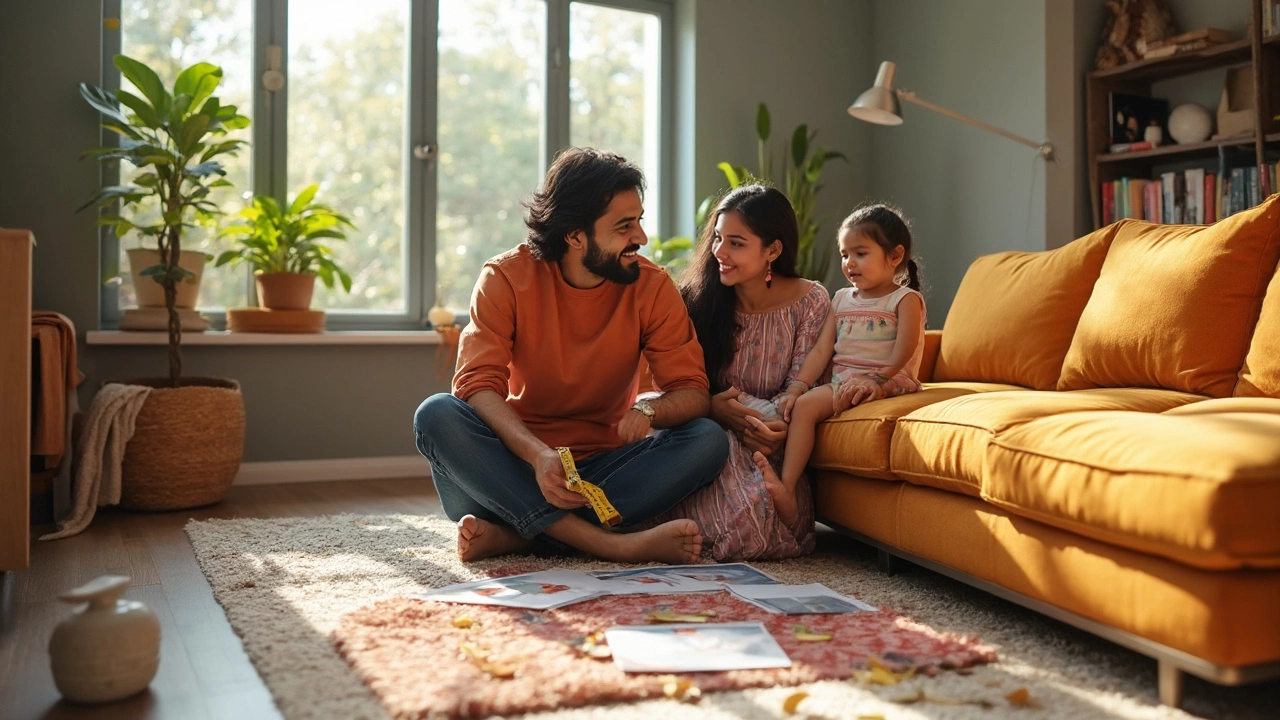Ever walked into a store, seen a gorgeous corner sofa, and thought, “Yep, that’s the one”—only to realize later it’s way too big for your living room? Happens more often than you’d think. Getting a corner sofa isn’t just about what looks good. Start with a tape measure. Know exactly how much space you have, including doorways, radiators, and windowsills that could get in the way. Forget eyeballing it—actual numbers save a lot of headache.
It’s not just about fitting the sofa in, either. You need room to walk around, stretch your legs, maybe toss a blanket or set down snacks. Don’t leave it up to guesswork. Quickly sketch out your room, or use free apps that let you test sofa shapes in a virtual space. A few minutes doing this beats fighting with furniture or dealing with scrapes on your walls.
- Measure Your Space Like a Pro
- Pick the Right Layout for Your Room
- Materials and Comfort: What Matters Most
- Practical Extras and Common Mistakes
Measure Your Space Like a Pro
You’d be surprised how many people skip this step and end up squeezing their brand-new corner sofa through the door, only to hit a wall—literally. So, you’ve got to measure first, and actually jot down the numbers somewhere you won’t lose them (like on your phone, not a random napkin).
Here’s the golden rule: measure everything, twice. Grab a tape measure (not a ruler). Start with the obvious—length and width of your available floor space. Don’t forget height if you’ve got low windows, shelves, or radiators. Write down these numbers:
- Distance from wall to wall in the part of the room where you want the sofa
- Clearance between the wall and things like heaters, built-ins, or window sills
- Doorways, hallways, and stairways the sofa has to pass through for delivery
- The ceiling height near the sofa’s future spot
Here’s a quick table to keep your numbers organized:
| What to Measure | Minimum Recommended (in cm) | Your Measurement |
|---|---|---|
| Wall-to-wall space | 250–350 | |
| Clearance in front of sofa (walking space) | 60–80 | |
| Door width (for delivery) | 76+ | |
| Window sill/radiator clearance | 15–30 |
Don’t just check the room—picture how people actually move through it. Will doors open fully? Is there space to walk with groceries without tripping over the new sofa edge?
Ever heard that the average UK corner sofa is between 210–260 cm on each side? Bigger living rooms can take up to 350 cm, but many people buy sofas too large and end up with cramped walkways. A few big brands now offer modular options you can test in-store, so see if you can try before you buy.
After measuring, lay out masking tape on your floor in the sofa’s exact shape. This low-tech trick helps you “see” how much space it’ll take—and where you’ll stub your toe if you’re not careful. It’s a lot better than guessing and regretting when it arrives.
Pick the Right Layout for Your Room
Getting the layout right can make or break your living room. A corner sofa is different from a regular couch because it naturally shapes how people move and hang out in your space. Some people call it a 'room divider that you can actually sit on.' That’s why L-shapes and U-shapes are so popular—they help mark out boundaries between the TV area, dining corner, or even a home office zone.
Before you place your sofa, there’s one big question: Which side should the longer part go? Left-facing or right-facing? Quick trick: Face the main seating section and ask, "Where do I want the long side to point?" That’s your answer.
- If your living space opens to a hallway, angle the sofa to create a simple walk-through.
- Have a nice window? Put a shorter section under it so you still get the view and light.
- Want a separate play area for kids? Use the back of the sofa as a low "fence."
- Open-plan place? Use the sofa’s back as an invisible wall for different zones.
Design experts say the wrong layout is a top complaint: "Around 42% of buyers feel disappointed after picking a sofa that blocks their path or clashes with their room’s flow," says a 2024 survey from UK-based Furniture Choice. Here’s a little more on common layouts:
| Layout | Best For | Room Size |
|---|---|---|
| L-Shape | Sectioning off space, fitting corners | Small to mid-size rooms |
| U-Shape | Group gatherings, bigger families | Large open rooms |
| Modular/Movable | Flexible setups, regular room changes | All sizes with enough rearranging room |
Another smart tip: leave 75-90 cm (30-36 inches) between your sofa and the coffee table so you’re not squeezed in. And try sitting in the spot where you’ll actually watch TV or chat with friends—does the layout feel natural? It’s what you’ll live with every day, so take your time setting it up.
“A corner sofa isn’t just furniture—it helps shape the energy in a room. Don’t be afraid to move it around until your space just clicks.” — Jo Sampson, Interior Designer

Materials and Comfort: What Matters Most
The vibe of your living room pretty much depends on what your corner sofa is made of. It’s not just about looks—materials decide how easy it is to clean, how long it’ll last, and how comfortable it’ll feel after hours of binge-watching shows.
Let’s break down some popular options. Got kids or pets? Go for microfiber or a tough synthetic blend; spills and pet hair clean up quick, and they don’t wear out fast. Leather is a classic for a reason—it gets softer with use and wipes clean, but it can feel chilly in winter and gets scratched easily if your dog has a thing for digging.
- Corner sofa comfort is all about the filling. Foam seats give a firmer sit and bounce back to shape, so you won’t need to keep fluffing them. Feathers or a feather-mix feel cozy but do flatten out, so you’ll spend more time plumping them back up.
- Look at frame quality. A hardwood frame usually outruns anything made from cheap particleboard. You don’t want to hear creaks every time someone flops down.
- If you tend to nap on your sofa or host overnight guests, test out the back cushions. Some corner sofas have high, supportive backs—awesome for lounging. Others go for low, modern lines that look cool but aren’t as neck-friendly for long movie nights.
- Check covers. Removable, washable covers are a lifesaver if you’re accident-prone or have young kids running around. Some even toss straight into the machine.
If you can, try before you buy. Plop down, wiggle around, pull up your knees. It’s the only way to really know if it’s a match. Your living room’s new hangout spot should be comfy enough that everyone fights for the best seat.
Practical Extras and Common Mistakes
Let’s talk about the features that actually matter—because nobody wants a pretty corner sofa that turns into a regret after the first Netflix night. Storage is a lifesaver, especially if you’re constantly dealing with clutter or tiny living spaces. Some designs have built-in compartments under the seats or built-in shelves on the arms. These extras are super handy for tossing in blankets, remotes, or board games instead of piling them on top of the sofa.
If you often have guests, look out for corner sofas that convert into sleepers. Pull-out beds aren’t just a gimmick—recent surveys show nearly 40% of sofa buyers regret not getting a sofa bed when they had the chance. And the new mechanisms aren’t nearly as awkward as they used to be. Modern ones are easier to pull out, and the mattresses are way more comfortable than the crunchy, spring-thin ones from years ago.
Another thing—removable covers. Kids, pets, or a love for red wine mean you’re probably going to spill something sooner or later. Go for machine-washable covers or stain-resistant fabrics. You can save yourself hours (and a lot of frustration) just by paying attention to that little detail in the shop.
Now, here’s what a lot of people get wrong with a corner sofa:
- Ignoring the orientation: Right-hand versus left-hand sofas matter. People mix these up all the time and end up blocking doors or windows. Look at your room layout before picking the sofa side.
- Skipping the sit test: You can’t really judge comfort from a picture. In stores, don’t just press the armrest, actually sit and lounge like you would at home. Is it deep enough? Too stiff? Don’t be shy about it.
- Forgetting delivery logistics: A corner sofa looks great in the store, but will it even fit around your hallway or up the stairs? Measure all entryways and think about awkward corners before you buy. Some shops will do this for you, but you can’t assume.
- Buying for looks, not lifestyle: The sleekest designer sofa might not survive a house with toddlers or pets. Durability should win over just looks if you’re going to actually live on it.
Take a look at this quick data table to spot what features are most valued by sofa buyers in the UK in 2024:
| Feature | Preference (%) |
|---|---|
| Storage | 54% |
| Sofa Bed Option | 39% |
| Removable Covers | 67% |
| Stain Resistance | 44% |
Shop smart, and you could easily avoid the pain points most people hit. Watch out for those basics—because the right extras and a bit of prep go a long way toward making sure your corner sofa is a win, not a regret.

